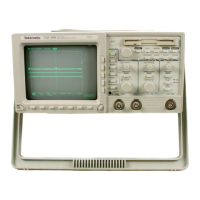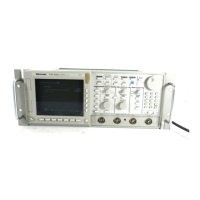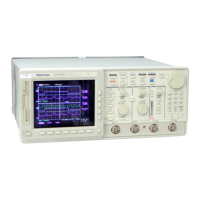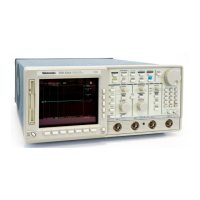TDS 340A, TDS 360 & TDS 380 User Manual
Index–1
Index
A
Aborting a hard copy, 3–41
AC input coupling, 3–4
AC trigger coupling, 3–12
AC trigger source, 3–12
Accessories
cables, C–4
optional, C–3–C–4
pouch, C–3
probes, C–4
standard, C–3–C–4
ACQUIRE button, 2–5, 3–25
Acquire menu, 3–25
Acquisition, 3–25
autoset default, 2–15
average mode, 3–26
defined, Glossary–1
envelope mode, 3–26
mode, 3–26
nominal specifications, A–7
peak detect mode, 3–26
performance verification, B–5
sample mode, 3–26
single sequence mode, 3–26
typical specifications, A–5
warranted specifications, A–1
Active cursor, Glossary–1
Air intake space, 1–2
Aliasing, 3–37, Glossary–1
Amplitude measurement, 3–20
Analog bandwidth, 1–1
Applications, FFT math waveforms, 3–31
Attenuation, Glossary–1
Auto trigger mode, 3–13, Glossary–1
Automated measurements, 1–1, 3–17
of FFT math waveforms, 3–35
Autoset, 1–1, 2–15, Glossary–1
defaults, 2–15
AUTOSET button, 2–5, 2–15
Average acquisition mode, 3–26, Glossary–2
B
Bandwidth
analog, 1–1
autoset default, 2–16
selecting, 3–5
Burst width measurement, 3–19
C
Cables, C–4
Cal menu, 3–59
Calibration test record, B–4
Camera, C–3
Carrying case, C–3
soft sided, C–3
Centronics interface, 2–8, 3–42
cables, C–4
CH 1, 2–2
CH 1 input, 2–7
CH 2, 2–2
CH 2 input, 2–7
Channel ground indicator, 2–6
CLEAR MENU button, 2–1
Clipping, FFT math waveforms, 3–37
Compensating a probe, 2–12
Compensation, output, 2–2
Config menu, 3–59
Connecting a probe, 2–12
Connector, chassis ground, 2–2
Contrast, 3–28
Controls
display, 2–1
horizontal system, 2–3
power, 2–1
trigger, 2–4
vertical system, 2–2
Conventions, performance verification, B–1–B–16
Cooling space, 1–2

